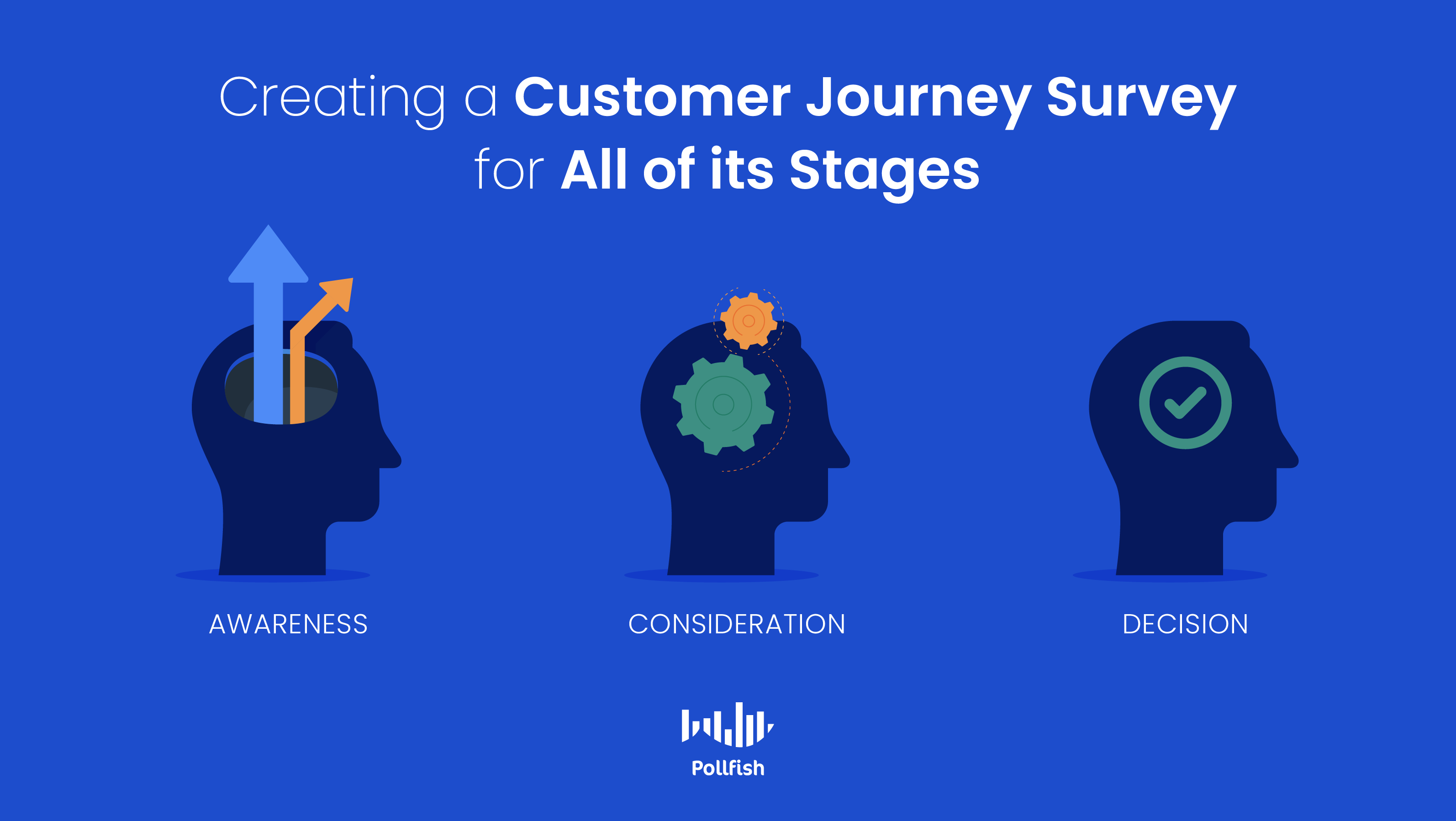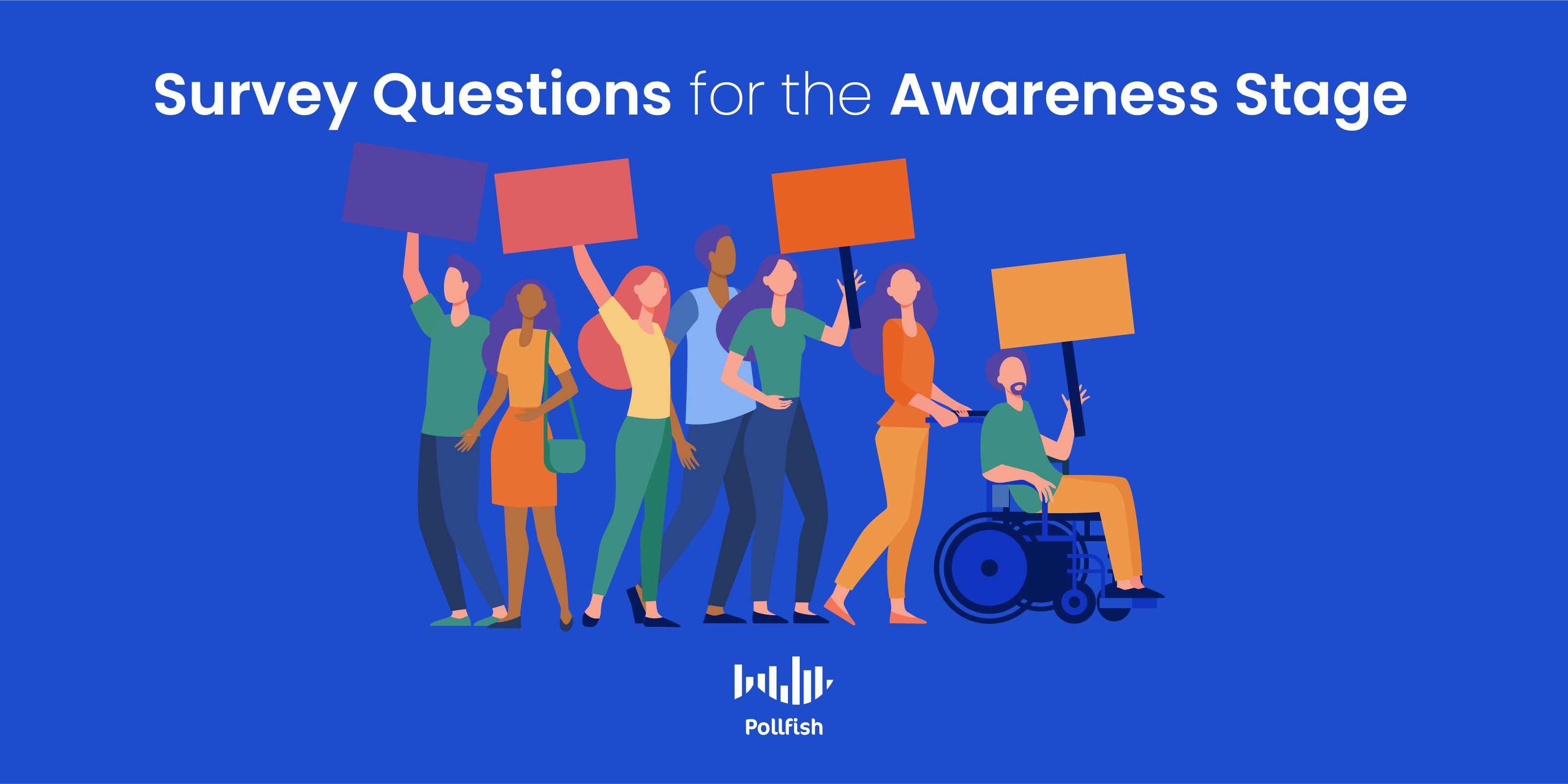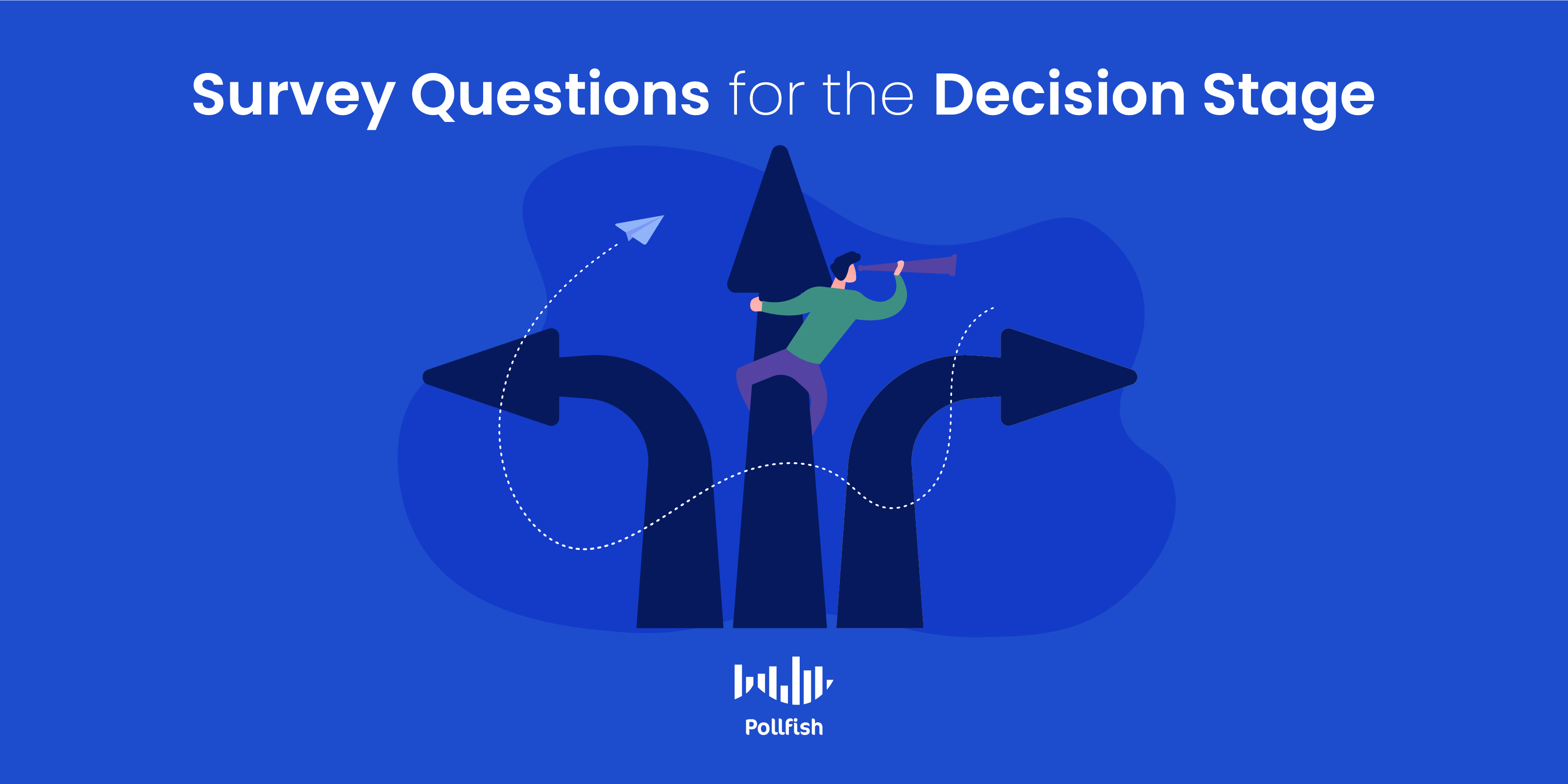How to Create a Customer Journey Survey for All of its Stages

Brands ought to create a customer journey survey to observe how their consumers traverse throughout their buying journey.
After all, 76% of customers expect companies to understand their needs and expectations, and It is the customer-centric companies that reap more profits, typically yielding 60% higher profits than companies that aren’t.
Understanding customers’ needs and expectations largely involves understanding their customer buying journey to properly cater to them, as no customer journey is exactly equivalent.
Some customers may undergo long customer journeys before converting. Other customers may detour and head straight to the checkout, while others may leave mid-journey without making a purchase or converting whatsoever.
This article explains the customer journey survey, why it’s useful and important, how to create one and the questions to use for all of its key stages.
Understanding the Customer Journey Survey
The customer journey survey is a kind of survey that examines consumers in relation to their customer buying journey, as its name suggests. It probes customers on the common things they experience and feel throughout their journey, including specific parts of it.
The customer buying journey is a path of all customers’ digital (and sometimes physical) visitations, behaviors and actions before they make a purchase.
This journey is a kind of process in which customers become aware of, examine and evaluate and make the decision to purchase a new product or service. In the digital space, these journeys do not always conclude with a purchase, as sometimes, they are cut short when a consumer decides to purchase elsewhere or not all.
The customer journey survey can be holistic, covering all parts of a customer journey that businesses either perceive or discover by previously surveying their customers or getting feedback via a voice of customer (VoC) program. This survey can also focus on a key aspect of the buying journey, such as one of its three main stages.
The three main stages of a customer journey are the awareness stage, the consideration stage and the decision stage. Businesses ought to deploy different tactics in their content marketing strategy, along with their ecommerce strategy so that customers stay engaged in each of these stages and are prompted to the next one, until they finally make a purchase.
The Importance of the Customer Journey Survey
This kind of survey is important in several ways. Firstly, it helps form the journey itself at a high level, serving as a tactic for customer journey mapping. This practice entails establishing a visual depiction of customer processes, needs & perceptions during their interactions and relationship with a business.
Customer journey mapping is as significant for small and medium-sized businesses as it is for larger enterprises.
Essentially, the customer journey survey allows businesses to map out the customer journey itself. Rather than forming one through assumptions or online templates, this kind of survey shows businesses exactly what customers are doing, thinking and feeling in their journey.
As such, the insights from this survey enable businesses to form their own customer journey maps which they can use for future marketing campaigns or for their strategic planning process.
By understanding the journey of your customers when they engage with your company, this survey type allows businesses to understand the steps customers take – which includes the steps that are easily accessible for brands and the ones that aren’t.
These steps are important for a number of reasons; they include triggers that incite customers to take some kind of action, whether that is clicking through an ad to its landing page, going further into their journey or finally making a purchase.
For example, these steps can include online review, in which 95% of customers read online reviews before visiting a business. 54% of shoppers comparison shop when they browse online, another crucial step in their final purchasing decision.
As such, it is important for businesses to understand the steps of a customer journey, as they shine a light on key customer insights, allowing brands to not simply map out their customer buying journeys, but optimize them.
In addition, being able to map out and improve the customer journey involves taking the proper steps towards making an impact. In this case, the customer journey survey is effective for configuring and optimizing budgets. This is because it shows businesses how customers are reacting to certain messaging, images, offers and other aspects of their customer experience.
In doing so, the customer journey survey is critical to improving your customer experience (CX), as it dictates how customers feel about a business and plays a major role in customers’ purchasing decisions. This survey helps improve CX, as it allows researchers to diagnose existing issues in their journeys, in turn, allowing businesses to tend to those issues, fix them and innovate more on their customer journey, products and CX as a whole.
Creating a Customer Journey Survey
Creating this kind of survey requires taking several key considerations.
First off, if it is your first customer journey survey, you may need to first form a high-level customer journey map that lays out your expected customer journeys. In order to map out this preliminary customer journey, use an analytics source, such as Google Analytics, or a specialized one, such as one that offers session replay.
These tools allow you to access key analytics on your digital traffic, allowing you to see how a customer made their way to a webpage — whether they clicked on an ad or arrived organically — the duration of their visit, how they traversed a site, how they engaged and more.
These insights will help you design your customer journey map and allow you to categorize your journey into the three aforementioned stages of awareness, consideration and decision. It won’t give you much insight into the kinds of customer personas and segments that are taking these journeys. That’s where the customer journey survey becomes incredibly useful.
Not only does this survey let you examine customers’ stages and mindsets throughout their journeys, but to identify the kinds of journeys typical among your customer segments and personas.
After you parse through your analytics and other digital traffic tools, refer to your customer segments and their habits. If you do not have access to this, you should conduct market segmentation, another practice made possible thanks to consumer surveys.
Once you have studied your customer segments, consider the segments and personas whose journeys you intend to survey. It is possible that you may need to survey them all to get a clear picture of your customer journeys across personas.
Either way, begin your customer journey survey by organizing each sub-campaign by each persona type. You can also group sub-campaign based on journeys in a certain marketing campaign, such as a particular offer or landing page. The most important thing is to pin down the purpose of your survey campaign so that you have a central point of study.
Next, consider which stages you need to survey; having observed your analytics helps you determine this. If you need to study all stages, consider creating surveys in chronological order. Come up with some key inquiries you need to be answered.
Then, choose from the question examples to use in each step of the journey from the examples in the following sections.
Survey Questions for Awareness

- What is the biggest problem you have with [something pertaining to your niche/products]?
- Answer type: Multiple-choice, multiple-selection, with an open-ended field option
- What bothers you the most about [completing an action, buying a product in your niche, etc.]
- Answer type: Multiple-choice, with an open-ended field option
- How do you usually go about fixing this problem?
- Answer type: Multiple-choice, with an open-ended field option
- What have you considered to fix/ tackle this problem?
- Answer type: Multiple-choice, with an open-ended field option
- Have you considered using [your brand] for this problem?
- Answer type: Yes or no, followed by a follow-up question on whether they’ve tried competitors’ products/services and another question on what they like/ dislike about them.
- Apply skip advanced logic to route your respondents to follow-up questions.
Survey Questions for Consideration
- What are your biggest concerns about [the problem]?
- Answer type: Multiple-choice, multiple-selection, with an open-ended field option
- What is the easiest way for you to solve this issue?
- Answer type: Multiple-choice, with an open-ended field option
- What would make you choose to try [your brand] if you haven’t already?
- Answer type: Multiple-choice, multiple-selection, with an open-ended field option
- What do you think of this selection? [Mid-funnel journey question for users of product pages, site menus, etc]
- Answer type: Multiple-choice, multiple-selection
- How would you rate our services based on the following? [Use image of an ad with a list of strengths relating to buying from your brand]
- Answer type: Rating scale, stars, etc.
Survey Questions for the Decision Stage

- When thinking about other companies that provide product X, which brands come to mind?
- Answer type: Multiple-choice, with an open-ended field option
- If all of the brands that can fix the problem had different prices, which would you purchase from?
- Answer type: Multiple-choice, Matrix question with options that mention price, capabilities and quality
- Which company are you most likely to buy from to fix your problem?
- Answer type: Multiple-choice, multiple-selection,
- Have you considered switching brands for this problem?
- Answer type: Yes or no, followed by a follow-up question on what would make them switch brands or try yours.
- Does this ad make you want to buy from us? [Use a multimedia file, such as an image or video that features your brand’s strongest capabilities to fix the customers’ problem.]
- Answer type: Yes or no, with an open-ended field option
- Answer type:
Optimizing the Customer Journey Survey
Being attuned to the customer journey is important, as it lets market researchers and businesses understand what their customers go through before finally making a purchase, or cutting their journey short before converting.
The customer journey survey assures that businesses can both map out their customer journey and understand their customers’ decisions throughout it. This kind of approach is strategic to better understanding customer expectations and is therefore crucial for optimizing the customer experience.
Aside from setting up this survey, market researchers need to use a strong online survey platform to carry out this survey campaign.
The most potent online survey platform makes it easy to make your own survey in three easy steps, offers advanced skip logic to route certain respondents to the correct follow-up questions, uses random device engagement (RDE) sampling to engage respondents in their natural digital environments, as opposed to pre-recruiting them, implements artificial intelligence and machine learning to disqualify poor-quality survey data and much more.
Businesses who use an online survey tool with these capabilities and more are well-equipped to create customer journey surveys, deploy them, map out their customer journeys and become well-adapted to their customers.
Pollfish Marketing Team
Ready to Try Pollfish?
Create your survey with AI, target high-quality respondents starting at $0.95 per complete, and start getting results in just minutes in real-time. From running a simple product concept survey to managing a constant stream of trackers for dozens of clients in dozens of countries, we’ve got you.
